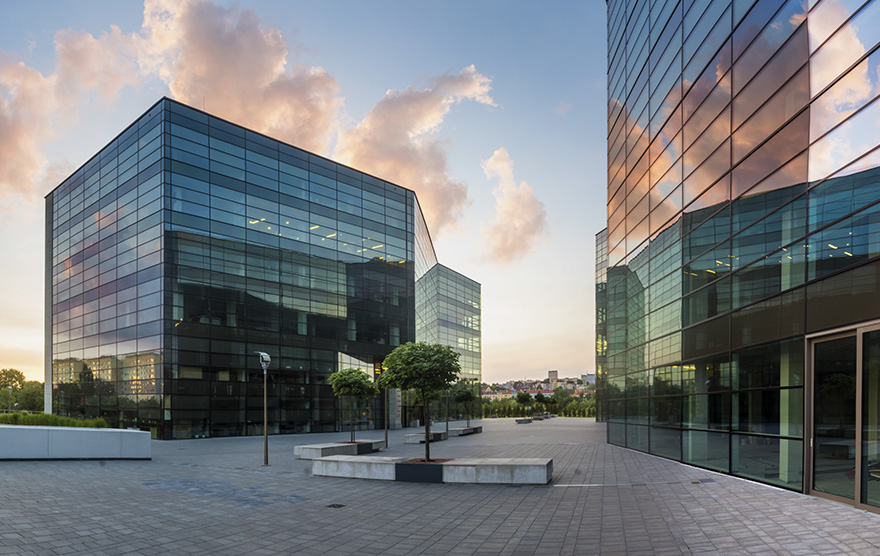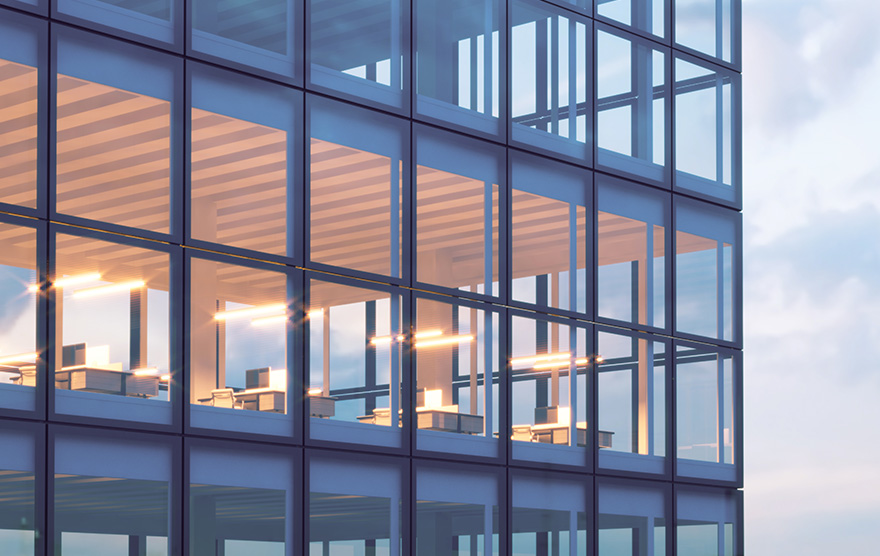If you’ve always marvelled at tall skyscrapers and corporate parks that use glass for huge windows and wall panels, then you might want to know more about float glass.
What is float glass?
Manufactured using a melt process, this architectural glass is made by recycling silica, sand, lime, soda and potash (they are melted and floated on a bed of molten tin). After solidifying, it is annealed to remove stresses induced during the cooling process as it also ensures higher density and refractive index.
It is one of the most widely used forms of glass in modern times and is used to manufacture various kinds of glass. It has a natural greenish colour and a transparent surface that transmits 87% of the light. Its thickness can range from 0.4 mm to 25 mm and this architectural glass can be coated with different kinds of metal oxides to produce tinted glass also.
Float glass has a strong and rigid structure. It can withstand chemicals and varying weather conditions which makes it quite durable.
Why should you opt for float glass?

Now that you have some knowledge about the manufacturing and properties of float glass, it is time to see why it is a favourite among customers. Float glass not only offers a stunning design but also has the following features which make it ideal for use in commercial spaces.
Durable
Energy Efficient
Versatile
Due to the rigorous and extraordinary manufacturing process, float glass has a strong structure that contributes to its durability. It is treated and cured in an oven for greater strength and has more density despite having the same thickness as that of plate glass. It makes it safe for installation in commercial spaces as it does not break down and shatter easily.
Float glass is a favoured alternative as it is an energy-efficient and environment-friendly product. This architectural glass has the ability to regulate the indoor temperature and can also be designed as a low-E glass (by coating with metal oxides). This high-performance glass reduces the carbon footprint as it is copper and lead-free and reduces the load on the heating and cooling systems, thereby reducing electricity consumption.
Float glass is quite versatile and can be used in multiple ways with slight modification and processing. It comes in varying shades, thicknesses and sizes to go well with many architectural and consumer requirements. We will be discussing the different glasses obtained from float glass in detail under applications of float glass to know more about how it can be used to achieve the perfect look in your office or commercial space.
Variants of Float Glass
Tinted float glass
Reflective glass
Tinted float glass is made using colouring agents during the melting process and the most common colours used are grey, bronze, green and blue. While it may seem that these colours, which are obtained by adding different agents like iron, cobalt, selenium, etc, only enhance the aesthetics it is not entirely true. The tinted glass has different properties like heat and light transmission/reflectance, ultraviolet transmission and insulation properties. This enables the customers to pick the tinted glass of their choice depending on the external environment for best performance and durability.
Float glass finds another application as reflective glass which is majorly used on the exteriors of commercial architectures. Light transmittance is an important design factor in this glass form. It is made by applying a metallic coating through two different methods during the manufacturing process. The first is a semi-conducted metal oxide coating and the other is a metal oxide coating. These coatings are applied during the pyrolitic and magnetron processes respectively in a vacuum on the inner sides of the glass panes.
Applications
Float glass has found use in all kinds of industries but is most widely used in commercial architecture (for interior and exterior) as it is a versatile product that offers several benefits like durability, strength and aesthetics. Here are some of the applications of this architectural glass.
Displays
-
Facades
-
Commercial glazing
-
Wall panels
Float glass finds its most common application in glass windows and is also known as window glass. Due to its crystal-clear transparent design, it has become an ideal choice to showcase items. It is used in retail shop windows and to display expensive items like jewellery, watches, etc without risking damage to the products, thanks to its durable and strong design that offers a brilliant lustre and smooth finish that enhances the aesthetic appeal with its luminosity. It is easy to clean which makes it maintaining it a piece of cake.
Facades are the glass structures that wrap the building exterior and are quite common in modern commercial architecture as it is simple, aestheitc and functional. It requires toughened and laminated glass and hence float glass proves to be a great alternative. Due to its toughness and efficiency, coupled with the ability to be glazed, it is widely used to create different types of glass facades like unitized curtain walls, stick glazing, tension system, frameless system, etc.
Float glass is also becoming popular in commercial applications as it provides strength to the structure and is easy to maintain. Float glass has found use as commercial glazing as it can easily replace large chunks of the wall both in the exterior and interior structure. It is toughened during the manufacturing process and ensures proper light and heat transmittance. It can be used as tinted glass or reflective glass depending on the customer’s requirements.
Be it partitions, personal cabins or conference rooms, wall panels can easily serve the purpose while increasing the visual appeal of the space. Tinted float glass can add a splash of colour, regulate inside temperature and offer privacy without breaking your bank account. It also offers heat reflective properties for further energy efficiency and high performance.
While these are some of the major applications of float glass, this architectural glass is also used to produce laminated glass, insulated glass, toughened glass, mirrors etc which means it can also be used to make table tops, and other products.
Now that you know about all the applications of float glass, it’s time to discuss a few points that one needs to keep in mind to ensure that it stays in great shape for a longer period.
- Excessive thermal stress can cause the glass to break due to uneven heating due to solar irradiance or other heat sources.
- Make sure to determine the wind direction before using float glass in high rise buildings as it may break if not toughened.
Get ready to make your commercial an eye-catching masterpiece with the help of float glass with help of leading glass manufacturing companies like AIS. Make sure to get expert advice and guidance during the initial selection process to create your ideal luxurious space!

